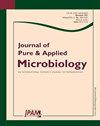Nasal Carriage and Antimicrobial Susceptibility Pattern of Staphylococcus aureus among Breastfeeding Mothers and their Infants
IF 0.7
Q4 MICROBIOLOGY
引用次数: 0
Abstract
Most S. aureus infections are multidrug resistant. S. aureus infections often occur with prolonged conditions, causing increased treatment costs and mortality rates. There is a need to understand the antibiotic susceptibility pattern to S. aureus in mothers and infants because the burden of S. aureus infection in infants is high. This study aims to determine the prevalence of nasal carriers of S. aureus in lactating mothers and their infants and their antibiotic susceptibility patterns. This cross-sectional study involved 59 pairs of breastfeeding mothers and infants aged 0 to 6 months. The research was conducted in the work area of the South Tangerang City Health Office. We take a nasal swab of the mother and the baby. We used Vitek-2 to determine antibiotic resistance against S. aureus. Overall, we found 22/59 (37%) S. aureus in infants’ noses, 18% of whom were MRSA. In mothers, we found 18/59 (30%) S. aureus isolates and 17% were MRSA. The majority of S. aureus isolates from infants were sensitive to cefoxitin (82%), gentamicin (86%), ciprofloxacin (91%), levofloxacin (95%), moxifloxacin (91%), vancomycin (100%), clindamycin (82%), erythromycin (86%), nitrofurantoin (100%), linezolid (100%) and tetracycline (77%). The majority of S. aureus isolates from mothers are sensitive to cefoxitin (83%), gentamicin (94%), ciprofloxacin (89%), levofloxacin (89%), moxifloxacin (89%), vancomycin (100%), clindamycin (89%), erythromycin (89%), nitrofurantoin (100%), linezolid (100%) and tetracycline (83%). MRSA monitoring of mothers and babies in the community needs to be done to prevent and control the spread.母乳喂养的母亲及其婴儿的金黄色葡萄球菌鼻腔携带情况和抗菌药敏感性模式
大多数金黄色葡萄球菌感染都具有多重耐药性。金黄色葡萄球菌感染通常持续时间较长,导致治疗费用和死亡率增加。由于婴儿感染金黄色葡萄球菌的负担很重,因此有必要了解母亲和婴儿对金黄色葡萄球菌的抗生素敏感性模式。本研究旨在确定哺乳期母亲及其婴儿中金黄色葡萄球菌鼻腔携带者的流行率及其抗生素敏感性模式。这项横断面研究涉及 59 对母乳喂养的母亲和 0 至 6 个月大的婴儿。研究在南坦格朗市卫生局的工作区进行。我们采集母亲和婴儿的鼻拭子。我们使用 Vitek-2 测定金黄色葡萄球菌对抗生素的耐药性。总体而言,我们在婴儿鼻腔中发现了 22/59 个(37%)金黄色葡萄球菌,其中 18% 为 MRSA。在母亲体内,我们发现了 18/59 株(30%)金黄色葡萄球菌,其中 17% 为 MRSA。大多数从婴儿中分离出的金黄色葡萄球菌对头孢西丁(82%)、庆大霉素(86%)、环丙沙星(91%)、左氧氟沙星(95%)、莫西沙星(91%)、万古霉素(100%)、克林霉素(82%)、红霉素(86%)、硝基呋喃妥因(100%)、利奈唑胺(100%)和四环素(77%)敏感。大多数从母亲体内分离出的金黄色葡萄球菌对头孢西丁(83%)、庆大霉素(94%)、环丙沙星(89%)、左氧氟沙星(89%)、莫西沙星(89%)、万古霉素(100%)、克林霉素(89%)、红霉素(89%)、硝基呋喃妥因(100%)、利奈唑胺(100%)和四环素(83%)敏感。需要对社区中的母亲和婴儿进行 MRSA 监测,以预防和控制传播。
本文章由计算机程序翻译,如有差异,请以英文原文为准。
求助全文
约1分钟内获得全文
求助全文
来源期刊

Journal of Pure and Applied Microbiology
BIOTECHNOLOGY & APPLIED MICROBIOLOGY-MICROBIOLOGY
CiteScore
2.00
自引率
0.00%
发文量
266
审稿时长
11 months
期刊介绍:
Journal of Pure and Applied Microbiology (JPAM) is a peer-reviewed, open access international journal of microbiology aims to advance and disseminate research among scientists, academics, clinicians and microbiologists around the world. JPAM publishes high-quality research in all aspects of microbiology in both online and print form on quarterly basis.
 求助内容:
求助内容: 应助结果提醒方式:
应助结果提醒方式:


